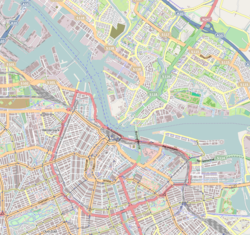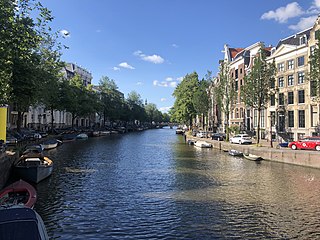
The Keizersgracht is a canal in Amsterdam, the Netherlands. It is the second of the three main Amsterdam canals that together form the Grachtengordel, or canal belt, and lies between the inner Herengracht and outer Prinsengracht.
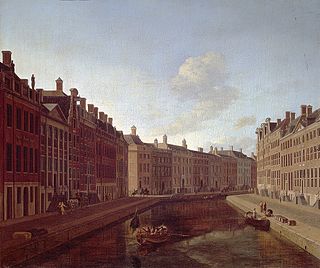
The Herengracht is the second of four Amsterdam canals belonging to the canal belt and lies between the Singel and the Keizersgracht. The Gouden Bocht in particular is known for its large and beautiful canal houses.

Finchcocks is an early Georgian manor house in Goudhurst, Kent. For 45 years it housed a large, visitor-friendly museum of historical keyboard instruments, displaying a collection of harpsichords, clavichords, fortepianos, square pianos, organs and other musical instruments. The museum was run by the owners of the house, Richard and Katrina Burnett. It is now owned by Neil and Harriet Nichols who use it as a family home and a venue for residential piano courses.

Jan Jacobszoon Hinlopen was a rich Dutch cloth merchant, an officer in the civic guard, a real estate developer in the Jordaan, alderman in the city council and a keen art collector. He would have been elected as a burgomaster, if he had not died at the age of forty, an age considered acceptable to be eligible. He was a prominent patron of the arts in his time, and there is some speculation on being an influential protector of Rembrandt and it is likely that he had good connections with Gabriel Metsu. Hinlopen, like his father-in-law, Joan Huydecoper I, is known in art history because of the poems by Jan Vos reciting the paintings in his house and members of the family. These paintings are spread all over the world, the poems nearly forgotten.

Jacob J. Hinlopen lived in a house with Hinlopen in the gable, now at 155 Nieuwendijk. He traded in cloth and Indian wares. In 1602 he was co-founder of the Dutch East India Company in Enkhuizen: his descendants inherited very old stocks. In 1617 he became the first person of Flemish origin to obtain a seat on the City Council.
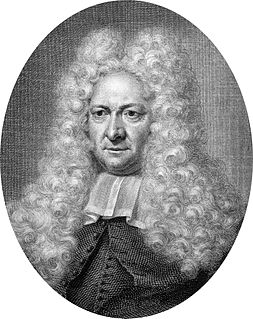
Lieve Geelvinck was the son of Joan Geelvinck and grandson of Cornelis Geelvinck and, following them into the vroedschap, he became administrator of the Dutch East India Company and member of the Council of State. He became mayor of Amsterdam for the first time in 1720. Through political marriage alliances, the Geelvinck family had already played an important role the council of Amsterdam for years on end, but in the first half of the 18th century all but one or two of the city's mayors were related to each other.
Nicolaes Geelvinck was lord of Castricum, Bakkum, Santpoort, Velsen, Stabroek, schepen, and owner of the country estate Akerendam-by-Beverwijk. He was appointed as mayor of Amsterdam in 1747, but in 1748 lost his seat in the vroedschap and as a counsellor to the Admiralty of Amsterdam, thanks to Mattheus Lestevenon.
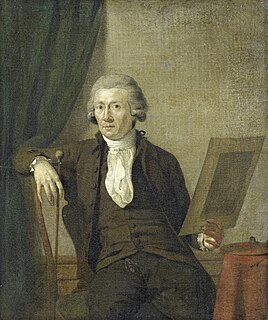
Egbert van Drielst began his study of the painting in a factory in Groningen which produced mainly lacquered objects. He soon went to Haarlem, where he became an apprentice in the wallpaper factory of Jan Augustini. Van Drielst entered the wallpaper studio in Amsterdam where he established friendships with Adriaan de Lelie. He studied the old masters Salomon van Ruysdael, Jacob van Ruisdael, Jan Wijnants and in particular, Meindert Hobbema, and sought to make use of their techniques in his nature studies. In 1768 he became a member of the Guild of Saint Luke in Amsterdam.

Lucia Wijbrants or Wybrants was the daughter of Johannes Wijbrants, a silk merchant, whose ancestors had moved from Stavoren to Antwerp. After 1585 when Antwerp was occupied by the Spanish army, the family moved to Amsterdam and lived in a house in the Warmoesstraat, then a fashionable shopping street. They had eight more children: only Hendrick (1623–1669), Helena (1628–1721), and Johannes survived.
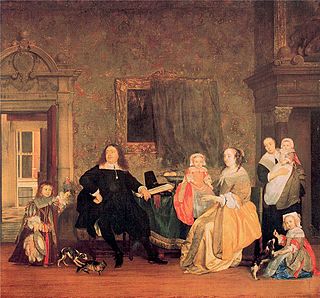
The Portrait of the Family Hinlopen or Family of burgomaster Gillis Valckenier is a painting in the Berlin Gemäldegalerie by the Dutch Golden Age painter Gabriël Metsu of about 1663. There have been various ideas among art historians as to which family is actually represented, with the two main candidates being the families of Jan J. Hinlopen or Gillis Valckenier, both wealthy and powerful figures in Amsterdam at the time.
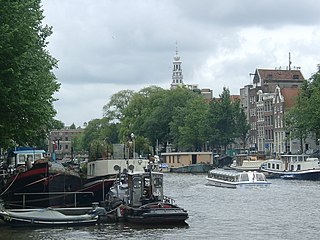
Constanti(j)n Ranst de Jonge was a Dutch businessman employed by the Dutch East India Company (VOC) who was chief of the trading posts in Tonkin and Dutch Bengal and three times opperhoofd of Dejima in Japan.

A canal house is a house overlooking a canal. These houses are often slim, high and deep. Canal houses usually had a basement and a loft and attic where trade goods could be stored. A special beam or pulley installation would be located in the attic to hoist up valuable goods, like spices, cotton, or heavier stuff like cocoa. In recent times, the pulleys are only used for moving furniture.

The Grachtengordel is a neighborhood in Amsterdam, Netherlands located in the Centrum district. The seventeenth-century canals of Amsterdam, located in the center of Amsterdam, were added to the UNESCO World Heritage List in August 2010. The Amsterdam Canal District consists of the area around the city's four main canals: the Singel, the Herengracht, the Keizersgracht, and the Prinsengracht. From the Brouwersgracht, the canals are generally parallel with one another, leading gradually southeast into the Amstel river.

De Negen Straatjes is a neighbourhood of Amsterdam, Netherlands located in the Grachtengordel, a UNESCO World Heritage Site.

Leather wallpaper is a type of wallpaper used in various styles for wall covering. It is often referred to as wrought leather. It is often gilded, painted and decorated. Leather was used to cover and decorate sections of walls in the houses of the rich, and some public buildings. Leather is pliable and could be decorated in various ways.

Jan Gildemeester Jansz. was a Dutch art collector.
Hans Bontemantel was a Dutch merchant and for a long time a schepen of Amsterdam, where he was born. He also served as acting-schout in 1672, whilst he was 'president-schepen'. As a supporter of Johan de Witt's political system, he was one of the nine regenten dismissed on 10 September 1672 by stadthouder William III of Orange, at the same time as the dismissal of Lambert Reynst, Andries de Graeff and Pieter de Graeff.
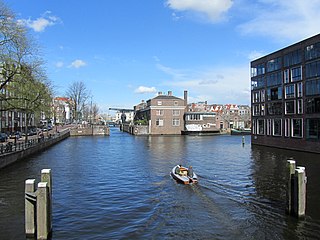
The Nieuwe Herengracht is a canal in Centrum district of Amsterdam. The canal is an extension of the Herengracht that runs between the Amstel and the Scharrebiersluis (lock) leading to the Schippersgracht from the Entrepotdok. It is in the Plantage neighborhood in the eastern part of the Grachtengordel.

The Nieuwe Keizersgracht is a canal in Amsterdam, part of the eastern Grachtengordel.

